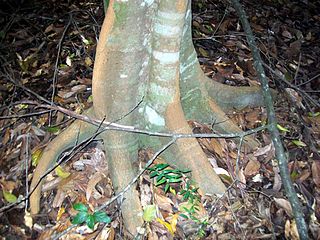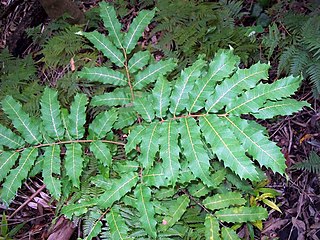
Leptospermum is a genus of shrubs and small trees in the myrtle family Myrtaceae commonly known as tea trees, although this name is sometimes also used for some species of Melaleuca. Most species are endemic to Australia, with the greatest diversity in the south of the continent, but some are native to other parts of the world, including New Zealand and Southeast Asia. Leptospermums all have five conspicuous petals and five groups of stamens which alternate with the petals. There is a single style in the centre of the flower and the fruit is a woody capsule.

Leptospermum recurvum is a species of shrub or tree that is endemic to Mount Kinabalu in Malaysian Borneo. It has pale, flaky bark, broadly elliptical to almost round leaves, white flowers about 12 mm (0.47 in) wide and fruit that tend to remain on the plant for a year or two.

Leptospermum lanigerum, commonly known as the woolly teatree, is a small tree or medium shrub from the plant family Myrtaceae. Its common name derives from the conspicuously hairy capsules produced as fruit, along with the fine, silky hairs present on branches and leaves. L. lanigerum is widespread in many habitats, particularly in waterlogged areas such as moist, sandy coastal heaths, on river banks, riparian scrub, woodlands and on the fringe of montane grasslands. This species is endemic to Australia, with native populations occurring in New South Wales, South Australia, Tasmania and Victoria.

Hibiscus splendens, the splendid hibiscus, is a species of flowering shrub or tree in the mallow family, Malvaceae. Other common names include hollyhock tree and pink cottonwood. H. splendens is a fairly common plant native to eastern Australia. The range of natural distribution is from Wollongong in the state of New South Wales to Blackdown Tableland National Park in central east Queensland. The habitat is on clearings or disturbances around the margins of the drier rainforests.

Daphnandra johnsonii, also known as the Illawarra socketwood, is a rare rainforest tree in the Illawarra district of eastern Australia.

Endiandra muelleri is a rainforest tree of eastern Australia. Its habitat is in warm temperate rainforests on poorer soils. Distributed from the Allyn River in the Barrington Tops region in the south to Kroombit Tops to the north in central Queensland.

Cupaniopsis newmanii is a rainforest plant in the soapberry family. It is native to eastern Australia. The common name is long-leaved tuckeroo. A rare plant, with a ROTAP listing of 2RC-. The habitat sub tropical rainforest ranging from Mullumbimby in New South Wales to Gympie in south-eastern Queensland.

Decaspermum humile, commonly known as the silky myrtle, is a tree from Australia and Asia. It can be used as bush food, as indicated by the alternate common name of currant myrtle. The tree features an attractive dark glossy crown. The new pink leaves with silvery hairs are particularly appealing.

Corynocarpus rupestris, commonly known as the Glenugie karaka, is a rainforest tree found in eastern Australia. It is a rare plant with a ROTAP rating of 2VC-t. There are two sub-species; arborescens is a small hairless shrub or tree up to 13 metres (45 ft) tall with a stem diameter up to 40 cm (16 in), and sub-species rupestris grows only to 6 metres (20 ft), with a stem diameter up to 17 cm (7 in).

Leptospermum jingera, commonly known as the stringybark tea-tree, is a species of shrub that is endemic to Victoria, Australia. It has papery bark on the larger branches, smooth bark on the younger stems, narrow egg-shaped to elliptical leaves, white flowers and silky-hairy, hemispherical fruit.

Leptospermum polygalifolium, commonly known as tantoon, jellybush or yellow tea tree, is a species of shrub or tree of the family Myrtaceae that is endemic to eastern Australia, including Lord Howe Island. It has thin bark, elliptical leaves, white flowers arranged singly on short side shoots and fruit that remain on the plant for a few years.
Leptospermum polygalifolium subsp. howense, commonly known as tea tree or tea-tree, is a flowering plant in the myrtle family, Myrtaceae. The subspecific epithet refers to the island to which the subspecies is endemic.

Leptospermum blakelyi is a species of shrub that is endemic to rocky clifftops near Lithgow in New South Wales. It has densely silky young stems, egg-shaped to elliptical leaves and white or pink flowers.

Leptospermum brevipes, commonly known as the slender tea-tree, is a species of shrub or small tree that is endemic to eastern Australia. It has fibrous bark on the main stems, smooth bark on young stems, narrow elliptical to narrow egg-shaped leaves, white flowers and hemispherical fruit that is shed when mature.

Leptospermum namadgiense is a species of small shrub that is endemic to areas near the border between New South Wales and the Australian Capital Territory. It has silky-hairy, narrow lance-shaped to elliptical leaves, usually white flowers borne singly or in pairs on short side shoots, and fruit that falls from the plant shortly after the seeds are released.

Leptospermum neglectum is a shrub or small tree that is endemic to Queensland. It has elliptical leaves that are silky-hairy at first, white flowers on short shoots in leaf axils and fruit with the remnants of the sepals attached but that fall from the plant shortly after the seeds are released.
Leptospermum oreophilum, commonly known as the rock tea tree, is a shrub that is endemic to the Glass House Mountains in southern Queensland. It has firm, rough bark on the older stems, elliptical leaves with a short, blunt point on the tip, relatively large white flowers arranged singly on side shoots and fruit that remains on the plant until it dies.
Leptospermum polyanthum is a rigid, spreading shrub or small tree that is endemic to New South Wales. It has thin, rough bark, young stems that are hairy at first, elliptical leaves, relatively small white flowers and fruit are shed when the seeds are mature.

Leptospermum purpurascens, commonly known as the purple-stemmed turkey bush, is a shrub or small tree that is endemic to far north Queensland. It has bark that is purple when new, elliptical to broadly lance-shaped leaves, relatively small white flowers arranged in pairs and small fruit that falls from the plants when the seeds are released.

Leptospermum polygalifolium subsp. cismontanum, commonly known as tantoon, is a subspecies of flowering plant in the family Myrtaceae and is endemic to near-coastal areas of eastern Australia. It is a shrub or small tree with elliptical leaves and white flowers in spring.

















